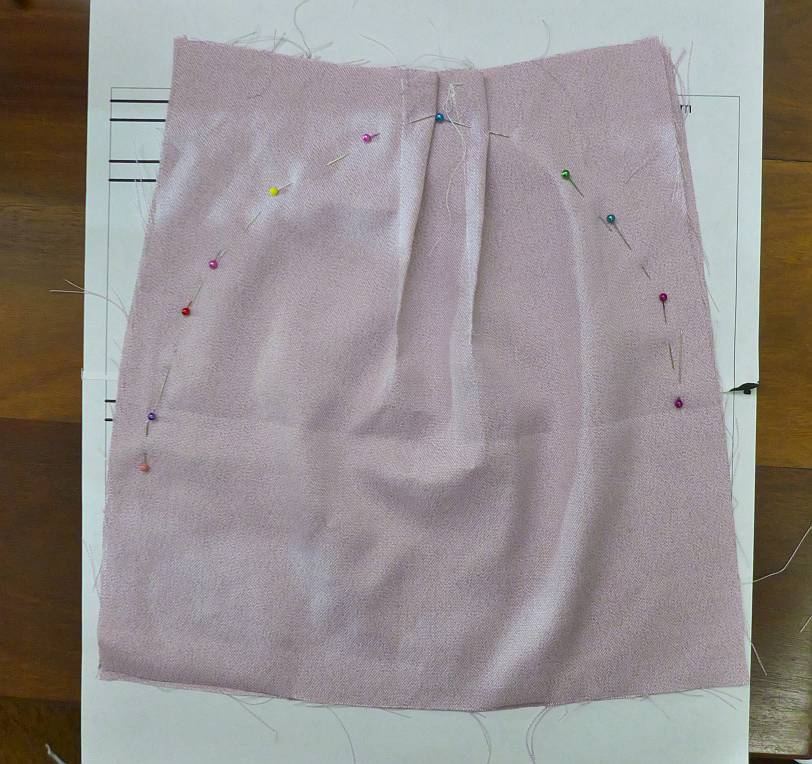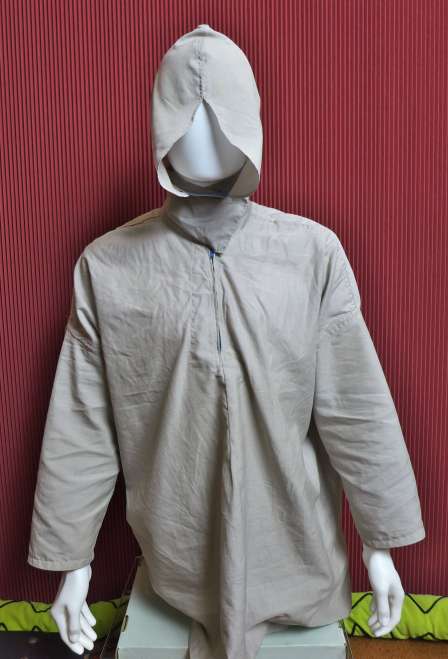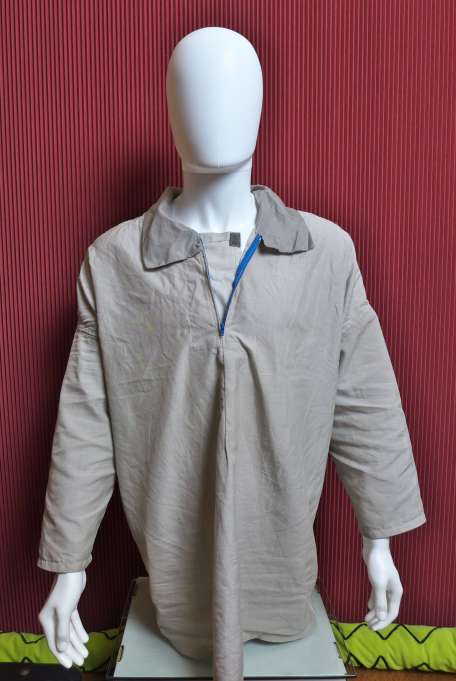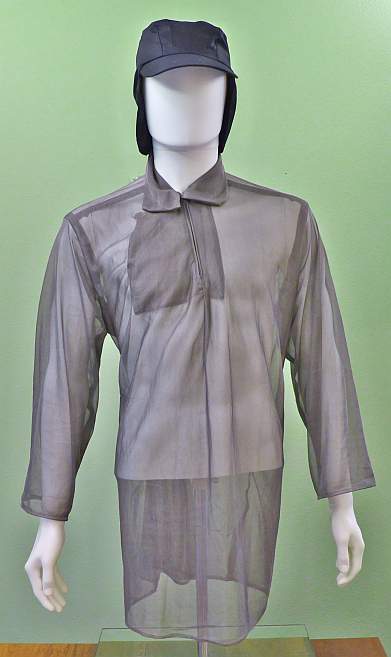
This is an old revision of the document!
Table of Contents
Wearable protection
there is NO CLOTHING COMMERCIALLY AVAILABLE which works well enough to improve healing
Design considerations
There have been two types of designs:
- Protection for when out in public. Often with compromised design to attempt to feel more comfortable in social and job settings.
- Protection for sleeping and in our homes. It may be that the strongest protection is essential during sleeping hours when the immune system doing it's deepest work.
Design constraints for #1:
Fabrics that can be put together in ways that fit in with local culture. Lighter weights can be made into tunics that fit under regular clothing. Hats provide head shielding but need augmentation around the neck.
Design constraints for #2:
Hands/Feet will need covering. Conduction gloves/socks can be purchased, but will wear out quickly. Fabrics should be to able to endure stretching, pressure over time without breaking down.
To properly shield for sleep your clothing should cover from the tips of your toes to the tips of your fingers to the tip of your nose, and everything in between. For daytime use you can roll back the sleeves (or remove the shielding gloves) and roll up the trouser cuffs. The shielding socks can be worn under whatever other socks you are wearing.
You might want to wear a hood with a face-hole during the day, or, if you find you are less sensitive than me, maybe just minimal shielding like the Winter Hat.
Best to make it all from Sleeping hat material Silver78#B. The Silver 30# mesh is lighter and good for surface-to-surface conductivity (I use it at my collars and hoods) but it wears out quickly, especially if the fabric gets stretched (even once). Dmitry posted May '18 “If you ask for 3 sets at once Christina can offer a little discount(like 10%) - her savings on delivery. I'm going to order 3 sets but this time with longer sleeves and trousers to roll them out while sleeping and roll up while wearing.”
Prof. Marshall replies Silver #92 is the best shielding fabric we have right now especially for under-layers.
Joyful We have found a fabric that can handle being worn as a layer under regular street clothing for full shielding. This fabric lowers the power levels up to 40db (10,000x).
It is not inexpensive, but it is the best we have found up to this point: quality shielding
I have made a set of clothing. The pants are patterned after loose fitting pajama bottoms. The top is patterned after a loose fitting turtleneck with a hood with drawstring added.
Two improvements I need to make to the above clothing: 1. Sleeves need to be longer and have “pockets” at ends so hands can be pulled in and covered. 2. Leg ends need to be longer and have some kind of “stirrup” loop under foot to keep them from pulling up.
I also want to make a set of “socks” for my feet from the #92 (spandex) material. The socks will be long enough to come up to just below the knee with one seam lengthwise and then across at the toes.
CousinTC Anyone want to learn how to sew leggings? Make your own pattern? I just learned and it worked very well with the Silver 92 fabric…EZ and quick! Least amount of material of any other plan. I will put up a photo when I can.
How to Sew a Pair of Leggings, two ways—for any age! - YouTube.webloc How to sew
Tip: Adults, Don't fold down waist band for yoga waist band when tracing for pattern. Tip: Make legs 6 inches longer to tuck in socks or make attached feet stockings.
Prof. Marshall: I suggest getting some 3/8“ to 3/4” elastic for the waistband. The more you stretch the #92, the faster it will lose its silver coating. A loose fit will always be better for an undergarment. Also, the trousers are best over the top of the torso garment, where the elastic can hold the two clothing layers together and make sure no waves can creep in. So they need to be tall, and the legs longer
CousinTC #92 Sleeping Suit
I made pants using this tutorial: How to sew I make them using the Yoga waistband as presented in the video except don't fold the waistband down. If anything, add height to the waistline. They have to be made large enough to not stretch when worn.
I made a shirt similar to Jful's. I used this pattern with a couple of changes. Pants can be made from this same pattern if the tutorial doesn't work for you.
The sleeve cuffs are an extra 6 inches and sewed all the way across the end of the sleeve opening to make mittens.
A non stitched area large enough to slip the hand through or the thumb is left open on the end of the inside side seam by the cuff. I did not cut any of the fabric away. Instead it can be tucked inside with a finished edge.
I did the same for the pants with a large enough unstitched area, below the ankle, to slip feet through the inside bottom seam. The bottom is stitched all the way across, Long ways so the toe goes into the corner.
At least 6 inches past the normal leg hem line is needed to make the bootie. If a hole is left on the bottom the feet slip through at night, which is why I like the self closing hole in the side seam.
The entire outfit is to give 100% coverage with only 2 pieces. 1 shirt, 1 pants.
..for best performance the trousers should be worn outside the hoodie, so that the elastic of the trousers presses the silver threads of top and bottom garments together.
mvanwink5 the machine needle that works for me in sewing the 92# fabric is the thinnest needle with a ball tip that says it is suitable for jersey fabric. Thick needles are trouble with this fabric.
Research team patterns
Joyful posted: Sun May 21st, 2017 We only have MEDIUM size patterns available at this time, but with a little work, they could be adjusted for smaller or larger sizes.
Also, the instructions are not quite complete.
Here are links to the patterns:
In two different parts of the USA we were able to email these files to a “reprographics” shop to be printed on 3' wide paper. Reprographics is the term used in the USA for blueprint printing shops. The pattern is around 12' long and the cost was less than $10 per pattern.
Overview and Definitions:
Partial Set of Instructions:
Yes, I am very grateful for the young clothing designer (still in school) who had the skill and the proper software to create the clothing (with your guidance) and the patterns.
Note about pattern layout on the #92 fabric:
Unlike many fabrics, the maximum stretch direction is along the selvage* (edges of fabric when on the roll).
Yes, the #92 is a 4-way stretch fabric, but you will want to layout the patterns so the stretch direction lines are aligned with the selvage edges.
*Definition of Selvage by Merriam-Webster
Posted: Tue May 23rd, 2017 FABRICS
UPDATE: Eva Lou moved shop from DHGATE back to AliExpress
#92 is listed as 4-Way Stretch Silver EMF RF Shielding Fabric @ AliExpress. Width = 165cm. #78B is listed as Bamboo Silver Fiber Shielding Fabric @ AliExpress. Width = 160cm. #30 is listed as Shielding Fabric Silver Coated Nylon @ AliExpress. Width = 150cm.
For the pattern we've just posted, the intention is to use the #92 fabric.
The #78B fabric is comparable in effectiveness, but has no stretch.
Therefore, adjustments to the pattern would be needed for an outfit from the #78B.
mvanwink5 posted: Sun Apr 30th, 2017
I have found the 92# to be more durable than 78#. I don't know about soft-n-safe.
Brain/Heart/Gut/Gonads
Big eye opener re: soft & safe fabric … I took a length of fabric to a non-MP contact last week as she thinks she has EHS.
When I arrived she had been struggling with a 3-week long headache (ever since returning home from a trip).
My spectrum analyzer showed a neighboring DECT phone at -18dBm in her livingroom. (I felt a kind of pressure, hard-to-think sort of response to it myself.)
For her, as soon as the fabric was wrapped around her head babushka-style, the tension lines in her face disappeared and the headache lifted. I left a 3'x5' piece of the cloth for her to use with a request for her results.
This week she had her visiting daughter and son-in-law try it. Both had symptoms disappear. Son-in-law said blurry eyesight cleared. Daughter said dizziness lifted.
Joyful, April 2015
Head
Pattern
Liz and I have drawn a PDF which has 3 pages. The first is a 2/3 size drawing of the 13 inch by 13 inch pieces of S&S which will make up the shielded casing. The next two pages are 100% scale, you can print them on A3 or Legal size paper and tape them together if you want an actual size template.
Leave adequate space around the edges to allow decent size hems as the S&S material tends to fray. The 13“ by 13” initial size allows for these seams, and also allows for additional hemming to reduce fraying if you don't use a lining. The size of the two darts should be adequate for most head-sizes.
One side is pinned to the brow-line, the other pinned to the bottom of the hairline, or even a little lower. Then put on head and adjust pins for comfy fit.
Seams are sewn with normal cotton thread. Because S&S has a tendency to fray, the edges are sewn down too.
This hat is being made with a lining, so you repeat the above with your comfy lining material. You might choose a nice-looking lining material so that you can reverse the cap. That way you can put the lining next to your skin, or the S&S there if you feel a need to 'ground' the cap.
When sewing the lining and S&S together make sure you leave a gap at the back so you can turn it the right-side out! (this has already been turned, and the front pinned. The edges will look nice and sharp after sewing).
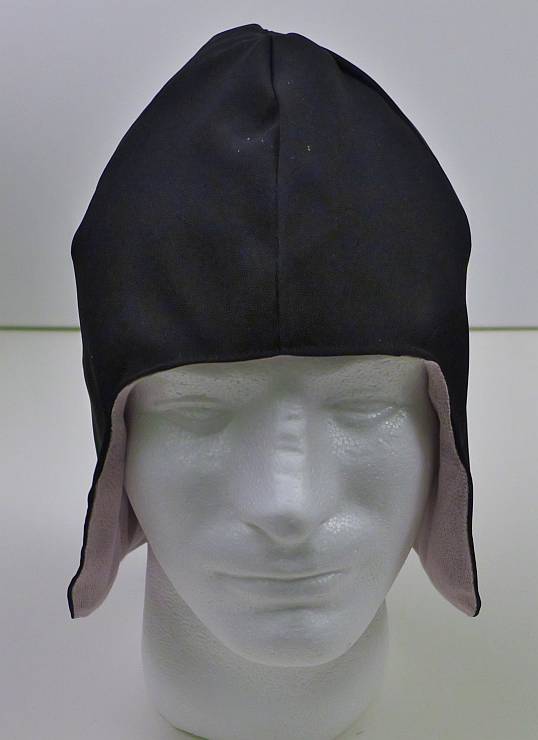 From the side, so you can see protection for the brain-stem
From the side, so you can see protection for the brain-stem
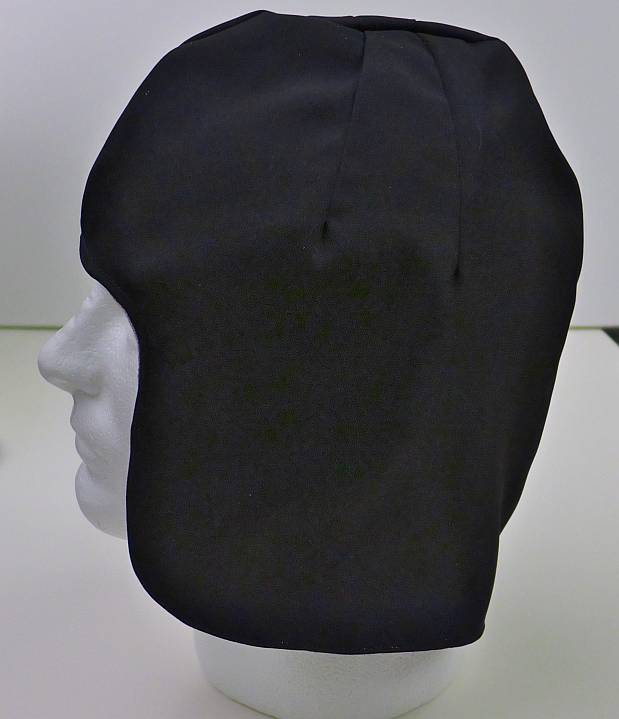 Here is the S&S side outwards, you can see the zigzag seam which attempts to reduce fraying. The lining helps reduce fraying too, especially above the eyes. This mode is comfortable for sleeping in, you might want a strap under the chin to keep it in position. A little velcro will allow for adjustment of the strap.
Here is the S&S side outwards, you can see the zigzag seam which attempts to reduce fraying. The lining helps reduce fraying too, especially above the eyes. This mode is comfortable for sleeping in, you might want a strap under the chin to keep it in position. A little velcro will allow for adjustment of the strap.
 I have been asked how much brain needs to be protected. I usually say that one inch below the bottom earlobe, and one inch in front of the ear, is the goal.
I have been asked how much brain needs to be protected. I usually say that one inch below the bottom earlobe, and one inch in front of the ear, is the goal.
I recommend buying the capilene skull cap to wear under the hood and absorb the sweat from your upper head. Especially if you have a bald patch, like me.
I ordered the CAP TW SCULL CAP
Item No.: 28680
from Patagonia, and it has been superb, if a little expensive. It's cheap insurance for the hoodie.
Q: “Is the capilene fabric warm?”
A: “Only when you are cold. It is an amazing (IMO) fabric”
Spine
After shielding the brain and brain-stem there is some advantage in also shielding the torso, and a much lesser benefit from protecting the legs.
It is important to maintain a 'faraday cage' integrity to the shielding, and not to try and cut corners. Primary is the need to overlap any joints with at least 2-3 inches flaps.
This torso shield is made out of sleeping-hat fabric. Heavier, it also feels less fragile when worn as a sleeping garment, etc. It basically is just a tube with a zip at the top so you can fit it over your head, and a collar to mate with a sleeping cap
pictured shape is Simplicity 2741 pattern, modified as shown in the photos.
And here is the compulsory overlap behind the zip. It is sewn at the side and bottom to one side of the zip, and a single conductive velcro spot holds it in place.
As at July 30 2015, the best garment we have made is shown below. It is made out of Silver87# mesh, a heavier mesh than Silver30#(45gm/sqm vs 27gm/sqm) and just as easy to sew. It stretches a little more in both directions than Silver30#, and this is why we chose it. The mesh washes and dries instantly, and weighs less than 4 ozs. Worn over Patagonia cloth underclothing, it disappears under a dress shirt, or any other outer garment. One of our mass production Winter Hats is shown here, also:
Essentials in fabrication
It is important to maintain a 'faraday cage' integrity to the shielding, and not to try and cut corners. Primary is the need to overlap any joints with at least 2-3 inches flaps. The examples were made using conductive velcro pieces rather than buttons. The collar is large so it can be folded up and the sleeping cap fastened around it, so that there is overlap there, too.
Normal cotton/polyester yarn works well. It holds the silver in the fabric together firmly, yet with a little bit of elasticity. I don't see how the silver threads could do as good a job as normal cotton/poly thread.
The sleeves have to be full length. I occasionally got some weird feelings up my arms when holding my (working) cellphone in my hand. The hands/arms are clearly conducting signal into the torso
No seamstress can unassisted produce a decent shielding garment.
I have used a much larger overlap flap at the top in my mesh fabric torso than in my earlier one, but the earlier one still works fine for me. If you are replicating this I would put more overlap beneath the zip, both at the bottom and side
mvanwink5 I think if the material was a complete loop, using a vertical zipper to snug it up that would work, but to do it right there needs to be top and bottom overlap with torso and head cap.
those covers which are of the form of a T-shirt around the torso work better than those with a split at the front. Zips down the front tend to stop them working properly. Zips have to be made very short, and large flap overlaps must be placed beneath any zip.
Notes
The sleeping hat fabric, and especially the silk 66 and mesh 30, are so lightweight they even disappeared under my dress shirt. The mesh 30 has the advantage that it breathes quite well, and stretches a little. It worked well for my leggings (hidden under trousers), but does snag easily if it gets near velcro (it sticks firmly to velcro).
I used Silver 87# in the 'torso tube' and Silk66# in the Simplicity 2741 pattern torso smock. Liz took the pattern for the shorts from that same pattern and made them from Silver30# mesh. She then attached long legs to them, and I wear them under trousers. This mesh 'breathes', works well, stretches a little and doesn't fray at the edges (easier to sew). But it is not as strong as either of the other fabrics, and catches easily. It doesn't seem to 'run' though, and is 1/4 the weight of the sleeping caps fabric. It is excellent for under-garments which don't need to touch the skin.
The collar is long, as it is usually folded upwards to fit under a 'sleeping cap' protective garment during sleep or a mesh bag in airports. If you have the conductive velcro it won't do any harm to put s square of it on the neck of the collar.
Keep the zip below the collar, it is purely to allow your head to get through.
wirion 2018: Just a heads up on the socks and gloves, ask Christina to add in elastic bands. She didn't put them into mine and so, although they can be tucked under the shirt's wrist band and the trouser's ankle band, they often come off during the night.
Cousin TC 2018: This week, I received my Christina made 081 Soft and Safe Rose hoodie and pants. I had asked her to leave the sleeve and ankle hems an inch or two longer than my size so I could pull them over. This is a beautifully made outfit and is soft like pajamas. As long as there is air movement, they are comfortable in the heat. Without air movement (such as a fan) they would be too warm for me to sleep in in the heat. As I asked Christina to make them baggy, I would not wear them under my street clothes but in time, it is my experience that they will shrink and will eventually be able to be worn under baggy pants and shirt.. Christina did exactly as I requested. I am very happy with her work and with the ARF design of our EMF Protection Suits. Thank you for setting this up for us!
When to change protective clothing
jezzer asks Can I ask how to wash the 'winter hat' & sleeping hat' so as not to reduce their effectiveness ?
Prof. Marshall replies I wash mine in a capful the yShield detergent, but honestly, any 'organic' non-fragrance washing concentrate ought to do just as well. I did try some 'Johnsons Baby Shampoo' and that seemed OK. You have to use cold water, I use water at the same temperature as my hands. I let the fabrics soak for 10 minutes or so.
Do not wring them dry or hang in the sun. Dry them by rolling up in towels. The mesh can be instantly worn after drying on a towel - very functional indeed.
Measuring degradation
Most EMF-protective clothes eventually wear out, as the very thin metal threads woven into the fabric get stretched under repeated use and breaks. Trevor Marshall had this to say on how to detect fabric breakage:
Mike, the permittivity of free space is 377 ohms. That is for air. So the clothing has to be significantly less than that to shield you from waves in the air. When you measure the resistance all over your fabric it should be much smaller than 377. I typically use 10 ohms as my cut-off for end of life. A few areas might be higher than that (knees, elbows, etc), but if so, I try to patch them over with another piece of fabric.
Here is a good meter to measure them – one that doesn't automatically change range. Use it on the 200 ohm range. Use on 200 ohm range
The Soft&Safe pants I made continue to show no conductivity degradation. The 92# hoodie which I wear 24/7 continues to hold up as well, but now that warm weather is here the real test will start, the sweat test.
mvanwink5 May 7th, 2018
wirion 2017: I have the following multimeter: as shown The Ohm continuity setting I always select is 200, at exactly 180 degree opposite of the “Off” setting. I take it that this is not good enough then.
For the YX360-TRE-B, the 2 vendors don't ship to Luxembourg..
TM: Banggood is reliable, and ships fast, worldwide. They take Paypal and Yandex as well as a variety of credit and debit systems… Incidentally, they are my preferred supplier for rechargeable sniffer batteries:
Joyful ..an analog meter is recommended. Here is a less expensive one…
Sunwa 8-Function 19-Range Analog Multimeter, YX360-TRE-B YX360-TRE-B
Mind improvement
Trevor
The garments i have been wearing have done the job. I have been fresh, focused, and without migraines (etc). Haven't had to use a single Paracetamol on the whole journey to and from Bulgaria. The clothing we have now designed does work. I have been wearing the mesh hood, torso and leggings. Only wore the winter-cap+torso+leggings for the first two days of the conference, and fell asleep before dinner. The waves in a conference room with 80 people, all running their iPhone and laptops, are easy to underestimate. Wearing the hood fixed this, and wearing the winter hat over the hood makes it look a little less weird. We have to work on that weirdness… maybe a beekeepers hat or a face veil is a solution
Questions
*** jezzer posted: Thu Nov 24th, 2016 “Is there a linear relationship between the surface area of the body that is protected and reduction of the effects of EMF or is any small part of exposure going to give the same effect as no protection at all - ref. EMF propagating within the body ?”
TM “What you are asking is one of the most imponderable questions. You are asking whether microwave-photons passing through a body dissipate their energy purely in collisions with the body's particles (electrons,protons, bosons, quarks, black matter, etc) or whether their influence extends beyond their immediate surroundings (this dilemma is at the basis of all quantum electrodynamics).
In other words, does the water (which makes up the majority of a human body) 'conduct' microwave-photon energy from one point in a body's mass to more distant points? Does the microwave energy impinging on a finger affect only the atoms in that finger, or does that energy somehow affect the overall energy of the arm, the neck, the brain, etc. What is the function of nerves and the vasculature? Are they acting as cables? Perhaps as antennas?
There are two possible factors in this puzzle that I have accepted at this point. The first is simple - to note that if a body is at -60dBm, and wants to get to -90dBm, then that 30dB difference is 1000 times lower amplitude, and even tiny leakages will have an impact. If you are wearing a hood made of the best 50dB #92 fabric, for example, the size of the hole at the front (which your face, nose and eyes peek through) is going to determine whether the overall shielding performance is 50dB or close to zero.
Notice the elastic draw-cord around the face-hole. This allows adjustment of the size of the hole in order to draw it down small in difficult environments, or open it up when shielding is less important. Kinda like you use a Hoodie in a cold wind
In fact, this design can be made to look very much like a hoodie, with people most commonly noting “isn't it a bit chilly today” as you walk into a store…
The hole size doesn't have to go down to zero, especially if the impinging waves are a longer wavelength (like FM radio) where the whole hood looks kinda like a wire antenna. At the most common 4G frequencies here in California (700-900MHz) an inch or two diameter still allows for pretty good shielding. but for 5000MHz WiFi, you have to reduce that size by 5, which is kinda prohibitive, and a limiting factor to protecting the brain. Remember that the brain controls the immune system, your blood glucose level, and probably a whole lot more
Extend that thinking to a hole at the bottom of a torso cover (shirt), a hole which is typically more than a foot in diameter. If our body, perhaps through its nervous system, transfers 1/1000 of the energy from the waist to the brain then our target shielding of 30dB will not be reached by a hood alone, or even a hood and shirt firmly connected at the neck (see the drawstring around the neck to firmly connect to the 'shirt' collar?)
OK, that's the easy part to understand The second factor is whether the water at the basis of all life is actually a player in energy transfer. Is water a boson-like fluid (the quantum description), or is it just dihydrogen monoxide (the classical model). As more and more scientists observe nano-molecular sub-structures in water the classical model is being pushed to the background. Maybe water has the ability to redistribute energy throughout its mass. If so, then careful shielding of a whole body would be necessary to achieve our 30dB shielding target.
It actually isn't hard to achieve 100% shielding, the problem is to do it in such a way that other humans don't instantly label you as a lunatic (or worse). I have been working on that…
Tailoring service HK
“How do I order a set of hoodie/trousers?” you might ask… Here is the procedure we have worked out.
1. You send your measurements to Christina by email ( yangchristina008@gmail.com ), letting her know your Paypal account email 2. She sends a payment request to your PayPal account for around $250, depending on size, etc 3. You pay via PayPal, she makes the garments, and ships them to you (by DHL 3-day)
Christina Yang, Fashion Designer
yangchristina008@gmail.com
WeChat: YANGJUN8513
phone: +86-13632988513
Here is a complete list of the info you need to send:
1. Male/female 2. Height 3. Weight 4. Typical sizes of clothes bought at department stores (medium, large, small, etc..)
5. Jacket Measurements:
Across shoulders Chest Waist Hips Arm length Jacket length ( measure from middle of shoulder down the front for desired length )
6. Pants Measurements:
Waist Hips Overall length Inseam length Thigh Knee Calf Ankle
Don't forget to order a YX-360TR multimeter to measure the aging of your garment as time goes by. Instructions on how to do that are at this video:
Enjoy!
vwmusum 2017: The shielding clothing from Hong Kong is awesome!!! I got mine about 10 days ago. I tested it with both my “Sniffer” and my Coronet RF Reader devices and it drops the EMF signal like a stone! Have been wearing it almost constantly. It's SO comfortable, breathable and looks great. Best of all it’s reassuring knowing it works. The fabric Trevor selected is brilliant. I have been sleeping like I was drugged! Out cold. Dreaming like crazy and the dreams are very clear. This tells me it may be affecting my brain in some positive way.
Here is the info on the tailor Christina Yang: yangchristina008@gmail.com http://shenzhentailor.com/contactus/ If you introduce yourself and let her know your measurements she will send your Paypal account an invoice (will be about $220) to cover making the hoodie and trousers, and sending them by DHL express (took 3 days to get to me from Hong Kong).
Joyful 2017: My custom fitted black #081 (soft & safe) “sweat suit” style outfit has arrived and it is very nicely made! It paid off to send not only my measurements, but also some pictures of my own semi-form fitting clothing with tape measures stretched across the length/width.
Notes and comments
CALL fn is {{section> :home etc


